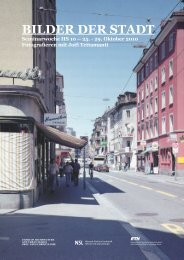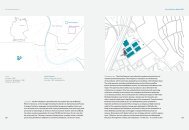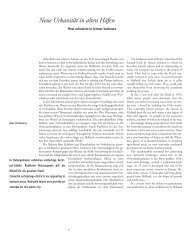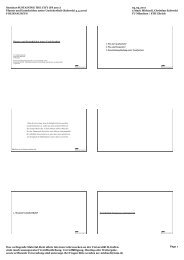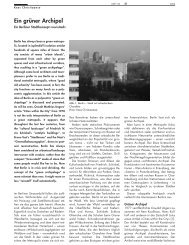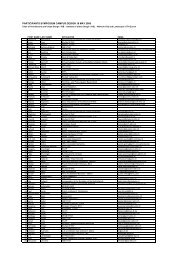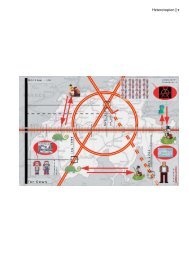dokumentation easa005.ch - professur für architektur und städtebau ...
dokumentation easa005.ch - professur für architektur und städtebau ...
dokumentation easa005.ch - professur für architektur und städtebau ...
You also want an ePaper? Increase the reach of your titles
YUMPU automatically turns print PDFs into web optimized ePapers that Google loves.
easa005<br />
topic: trans - transit - transition<br />
Today, for every inhabitant of Switzerland,<br />
there are 130m2 of public traffic space!<br />
One third of the whole settlement area of<br />
Switzerland is used as traffic space!<br />
(Herczog, “Von der Raumplanung zur<br />
Raum-Entwicklungsplanung”)<br />
alpine infrastructure<br />
The aim<br />
The topic of easa005 was “trans - transit - transition”. Lectures<br />
at the beginning showed practised methods and abstract, general<br />
and individual possibilities to work with and think about<br />
this topic. The workshops produced a concrete reaction on it<br />
in relation to the location. This was the chance to reflect about<br />
the different forms of alteration in Europe and Switzerland and<br />
of implementing the ideas into concrete solutions.<br />
EASA does not comprehend itself as a competitor or counter<br />
movement to established institutions and offices. The goal is<br />
much more an approach of the topic from “bottom up”, from a<br />
collective perspective of European Architecture students, who<br />
contribute their part to contemporary discussions.<br />
Transit being constitutional for Switzerland<br />
The history of Switzerland has always been strongly influenced<br />
by transit. The famous crossing of the Alps by Hannibal 218<br />
BC was one of the first of many crossings of a very dark, dangerous<br />
area, loosely inhibited by a strong and stubborn mountain<br />
people. Hannibal lost 20.000 men and a great deal of his<br />
baggage on his march to Rome. For centuries, the Alps were<br />
regarded solely as a nuisance, hindering travel and trade especially<br />
for Italy.<br />
This eventually changed in the 18th century, when the Alps<br />
became an object of romanticism and not an object of fear.<br />
Switzerland is situated in the heart of Europe and borders to<br />
three of Europe’s four biggest nations. Trade relations are intensive<br />
and the fact that trade, and not production, is a main<br />
issue in the Swiss economy, may also be a major reason for<br />
its neutrality.<br />
And of course, there is more and more invisible transit going<br />
on in Switzerland. The Swiss banks, for example, are important<br />
hubs for international wealth.<br />
Many of the Swiss myths are based on mountain passages.<br />
Transit is not only constitutional to the Swiss economy, but also<br />
to its mentality: Travelling between the isolated valleys was a<br />
laborious, dangerous thing to do, so the Swiss soon developed<br />
into specialists for bridges and tunnels.<br />
Trans - Transit - Transition as EASA-Topic<br />
1 – Europe is growing together. This does not happen automatically,<br />
it has to be actively achieved. Borders have to be<br />
crossed not only politically, but in many other senses, too. If<br />
we want to learn from each other in clever and constructive<br />
ways, we have to communicate.<br />
Switzerland has often been called a miniature paradigm for<br />
Europe, because it has achieved the unification of many different<br />
languages and views into a well-functioning democratic<br />
country with a strong identity.<br />
2 – We live in an age of communication, and not only information<br />
is communicated, but also goods, persons, and ideas. Architecture<br />
is the place where all this starts and ends up, and urbanism<br />
deals with managing contribution and distribution. The<br />
multitude of things transported can almost not be grasped. As<br />
architects, we have to know about those processes and need<br />
to be able to deal with them.<br />
The Alps have always been strongly influenced by the transit<br />
of goods between North and South. Many of the effects of<br />
transitional processes can be observed when traversing the<br />
alp valleys. Roads, highways and railways are often stuffed<br />
into a narrow valley, joined by factories and power stations on<br />
the way. The efforts being made to tunnel the mountains are<br />
still enormous, most current example being the new Gotthard<br />
pass.<br />
3 – Our cities change constantly, more than ever before building<br />
and rebuilding themselves. This permanent evolution has<br />
its effects on both very large and very low scales. As architects,<br />
we have to deal with the complexity of these processes, without<br />
getting overwhelmed or megalomaniac. Solutions have to<br />
be fo<strong>und</strong> to make transitional streets, houses and cities to be<br />
worth living, without neglecting contemporary demands.<br />
transit<br />
W. Turner: Gotthard - Hannibal<br />
mind map trans<br />
Definitions: transit – transition (Encyclopedia Britannica):<br />
transit (noun)<br />
1 tran-sit / Function: noun / Etymology: Middle English transite,<br />
from Latin transitus, from transire to go across, pass /<br />
1a : an act, process, or instance of passing through or over;<br />
passage, 1b : change, transition, 1c : conveyance of pesons<br />
or things from one place to another, 2 : usually local transportation<br />
especially of people by public conveyance; also :<br />
vehicles or a system engaged in such transportation, 2 a :<br />
passage of a celestial body over the meridian of a place or<br />
through the field of a telescope : passage of a smaller body<br />
(as Venus) across the disk of a larger (as the sun) 3: theodolite<br />
with the telescope mounted so that it can be transited<br />
transit (verb)<br />
intransitive senses : to make a transit<br />
transitive senses<br />
1 a : to pass over or through : traverse : to cause to pass<br />
over or through, 2 : to pass across (a meridian, a celestial<br />
body, or the field of view of a telescope), 3 : to turn (a telescope)<br />
over about the horizontal transverse axis in surveying<br />
transition (noun)<br />
tran-si-tion / Etymology: Latin transition-, transitio, from<br />
transire<br />
1 a : passage from one state, stage, subject, or place to<br />
another : change : a movement, development, or evolution<br />
from one form, stage, or style to another, 2 a : a musical<br />
modulation : a musical passage leading from one section of<br />
a piece to another, 3 : an abrupt change in energy state or<br />
level (as of an atomic nucleus or a molecule) usually accompanied<br />
by loss or gain of a single quantum of energy<br />
documentation<br />
49<br />
appendix



